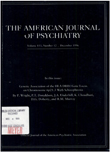Childhood sexual abuse and bulimia nervosa: a comparison of American, Austrian, and Brazilian women
Abstract
OBJECTIVE: This study was designed to assess the prevalence of childhood sexual abuse among women with bulimia nervosa in three countries: the United States, Austria, and Brazil. In addition, it assessed whether bulimic subjects might have experienced more severe sexual abuse than women in the general population and whether bulimic subjects who report abuse might display greater psychopathology than those who do not report abuse. METHOD: Thirty-three university students in Innsbruck, Austria, 33 university students in Boston, and 25 women in Sao Paulo, Brazil, all meeting DSM-III-R criteria for bulimia nervosa, were recruited by advertisement. Detailed histories of sexual abuse, obtained at the conclusion of a comprehensive evaluation interview, were prepared, translated into English, and rated by an investigator who was blind to the nationality of the subject. Subjects were compared on frequency of eating binges, history of major depression, body mass index, and satisfaction with body image. RESULTS: Narrowly defined childhood sexual abuse was reported by 24%-36% of women in the three countries, although only 15%-32% of women reported abuse before the onset of bulimia nervosa. There were no significant differences between countries in rates of abuse. Overall, these rates appear no greater than those reported in comparable studies of women in the general population. The data also did not support the hypothesis that bulimic subjects had endured more severe sexual abuse than other women, nor was there a significant association between history of childhood sexual abuse and severity of bulimic symptoms. CONCLUSIONS: These findings add to the weight of evidence suggesting that childhood sexual abuse is not a risk factor for bulimia nervosa.
Access content
To read the fulltext, please use one of the options below to sign in or purchase access.- Personal login
- Institutional Login
- Sign in via OpenAthens
- Register for access
-
Please login/register if you wish to pair your device and check access availability.
Not a subscriber?
PsychiatryOnline subscription options offer access to the DSM-5 library, books, journals, CME, and patient resources. This all-in-one virtual library provides psychiatrists and mental health professionals with key resources for diagnosis, treatment, research, and professional development.
Need more help? PsychiatryOnline Customer Service may be reached by emailing [email protected] or by calling 800-368-5777 (in the U.S.) or 703-907-7322 (outside the U.S.).



